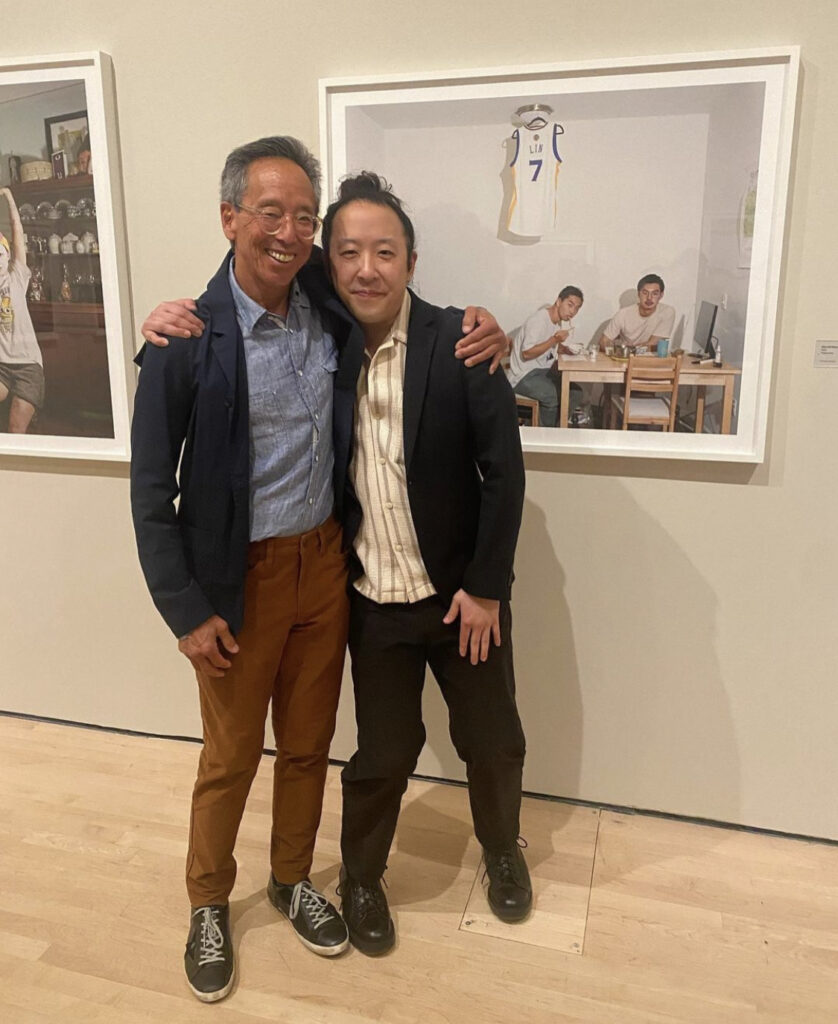
Reagan Louie and Jarod Lew at the exhibition opening of Kinship: Photography and Connection, May 2023; photo: Jarod Lew
Though separated by generations, the photography of artists Jarod Lew and Reagan Louie similarly capture the interplay of Asian culture and the American experience in works suffused with themes of identity, community, and place. SFMOMA invited these new friends to interview each other, resulting in a wide-ranging conversation between the Detroit-born Lew and Bay Area–born Louie about home, family, their careers, and the impact of Chinese heritage in each of their practices. Lew’s work appears in the exhibition Kinship: Photography and Connection, on view on Floor 3 through November 26, 2023. Louie’s work appears in the exhibition Sea Change: Photographs from the Collection, on view on Floor 3 from September 2, 2023, through February 19, 2024.
Reagan Louie: I have to acknowledge Erin O’Toole (SFMOMA’s Head of Photography) who introduced me to you and other young artists, which has been really inspiring. I had already retired from teaching — and this made me realize how much I missed it; how much teaching was part of my identity as an artist. I have always been inspired by my students, but in my last few years teaching I was particularly inspired by students from throughout Asia and Asian Americans.
The younger artists talked about form, but the emphasis wasn’t strictly about that. It was a great indicator that things were shifting. When I began making art, it was taboo to talk about anything but picture making, formalism, high modernism. Identity? Forget about it. That was considered a weakness.
With your generation, there’s much more freedom to explore. You’re building communities that I didn’t have, that didn’t exist. I’ve made a 180-degree turn in my journey as an artist. Coming up I was all about competition, now it’s all about community for me.
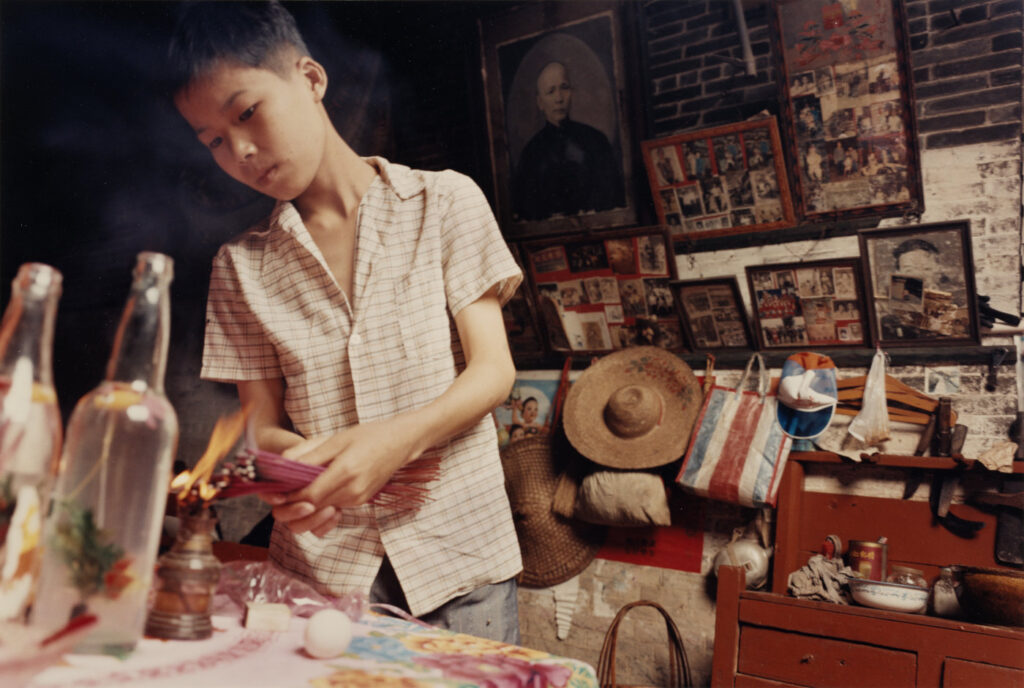
Reagan Louie, Ancestral Worship, Wing Wor, from the series Towards a Truer Life, 1983; collection SFMOMA, gift of Bill Press and Elana Auerbach; © Reagan Louie
Jarod Lew: I was thinking about your photographs and the photographs I’ve been making. It’s interesting how you, from another generation, went to China to find out more about yourself. Coming from a 2.5 generation Asian American household, my immediate frame of reference for my identity was my childhood home. So, my work tried to articulate a sense of rootedness within Asian American homes across the U.S.
That’s important to talk about, how you were forming these communities in China, outside of the country you were raised in. It’s like we were both trying to figure out the “placelessness” of Asians in America but by using different strategies.
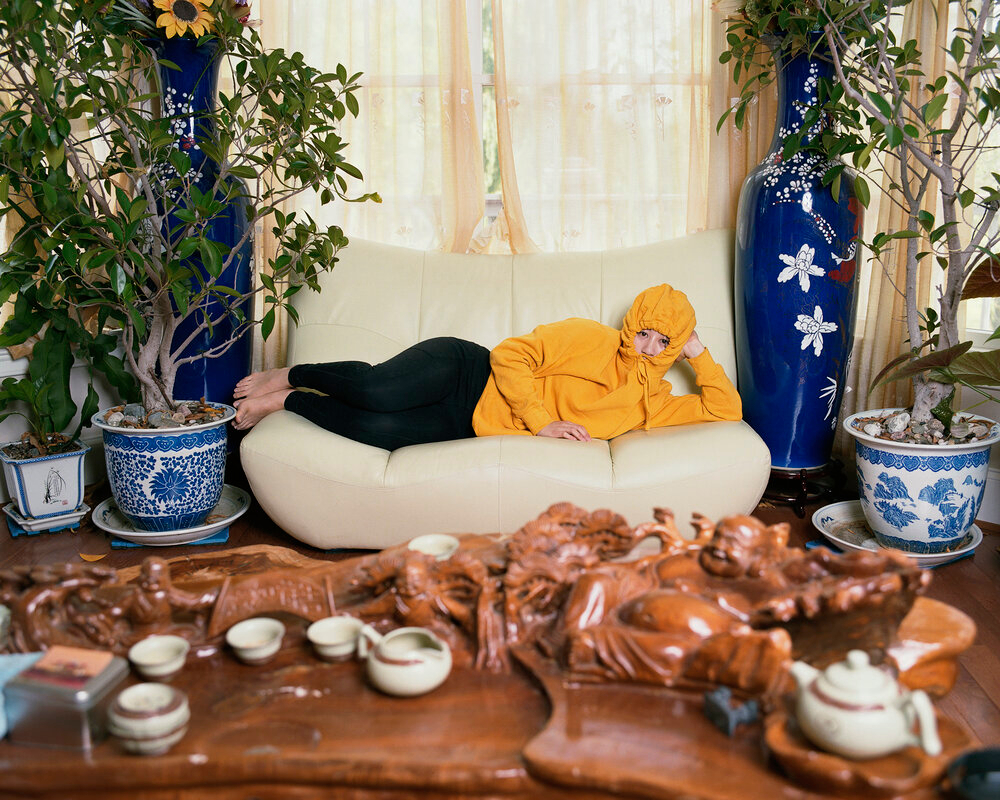
Jarod Lew, The Most American Thing (Tina), 2021; courtesy the artist; © Jarod Lew
RL: That’s the crux of it. The role of family or Chinese background . . . First, I have to make a distinction between immigration before and after 1965. To oversimplify, both groups came for a better life, but my family was part of the first wave of Chinese immigrants who came during the gold rush and to build the transcontinental railroad. While their labor was welcomed, they themselves were not. Once the work was done, they were turned against. At the worst there were massacres of Chinese communities throughout the West and, later, laws were created to exclude further Chinese immigration. Because of this racism and hostility, families like mine stayed in enclaves apart from larger society. Though I’m fifth-generation American, I was raised with this mindset for security. I didn’t speak English until I started kindergarten. And that’s why my family plays an immensely important role, despite my own refusal to believe it. It was a different situation for Chinese immigrants after 1965, who were welcomed as professionals or academics, though they still endured racism.
When I chose to become an artist, it was like, where did that come from? As the oldest son I should have been a doctor, lawyer, or at least a pharmacist.
JL: I distinctly remember that my parents looked at each other when I said, “I’m going to be a graphic designer.” Then they both looked at me while driving in the SUV and were like, “Oh no.” And then they were like, “At least in graphic design you’ll get health insurance if you work for a corporation.” What influenced you to become an artist?
RL: I was an indifferent student, but in college, I serendipitously took an art class and discovered a new curiosity about the world, and art just made sense. It gave me a new way to explore the world and myself. This was the sixties, right? Everything was open for new interpretations. There was no background for my decision. My father said, “How will you make a living?” I said, “I don’t really know.” That’s how idealistic you could be then. When I moved here in the seventies to teach at the San Francisco Art Institute, there was still this wonderful vibe from the sixties. But art was much more monolithic then. In the art world, you were allowed only one topic of conversation: modernism.
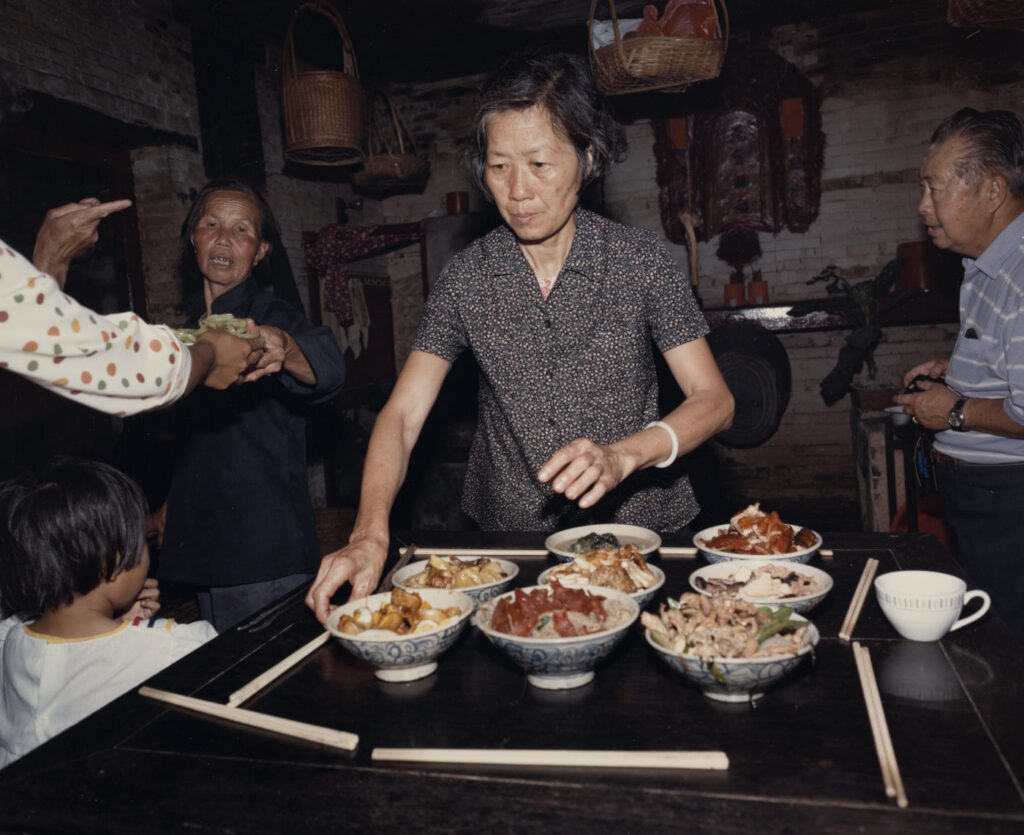
Reagan Louie, Aunt, Wing Wor, from the series Towards a Truer Life, 1989; collection SFMOMA, gift of Bill Press and Elana Auerbach; © Reagan Louie
I recently spoke with our mutual friend, artist and curator Yechen Zhao. He grew up in Michigan, like you, but was even more isolated because his family spoke a different dialect than everyone around them. He couldn’t speak to other Chinese if he wanted to. Yechen made an interesting point that you don’t have to know the Chinese language to be part of the culture. I think that’s true for successive generations as you drift farther away from your native culture. Growing up with the same cultural heritage, there’s a common way of thinking; like the concept of saving face . . . it’s hard to explain.
JL: You could understand it physically and in the moment, but there are no words that really describe that feeling.
RL: I had a long discussion with someone about the recent Asian shooters. That hit me hard because they’re my generation. That was an indication of the worst kind of assimilation, right? That was an American solution, not an Asian solution. The two men had lost so much face, become so unmoored from their community, there was no other option than the American way. In China, with its emphasis on the individual and the collective, it just wouldn’t get to that point. But in America, we’ve become so extreme in our individualism, we’ve lost that balance. It’s pretty tragic.
There are events and traditions most Chinese Americans still observe, like New Year, tea ceremonies when you get married, or red egg parties when you have children. This observance of tradition is true with all cultures. This is the new paradigm I want to begin to address in my work. And it’s being addressed in the work being made by you and other younger artists — integrating our unique heritage into this society we call America. Qingming, when you honor your ancestors, that’s a very important practice Asian Americans can bring into this culture.
JL: I was thinking about what you were saying about honoring ancestors. As a young Chinese American artist who’s investigating my own identity, there’s this disconnection because I can’t speak Chinese, but I’m studying and thinking about identity so much, it almost feels like I’m closer to my ancestors because I’m constantly focused on it. It exceeds language. You don’t have to be fluent in Chinese to understand what it is to be Chinese or Chinese American.
That is something that needs to be said for the younger generations who are working with their own identity and feeling discouraged by this disconnection. But if you’re constantly working at it there is an attachment. The traditions we observe to honor our ancestors, we are honoring them but honoring them in a different way that feels truthful to our own experience as current generations of Asian Americans living in America.
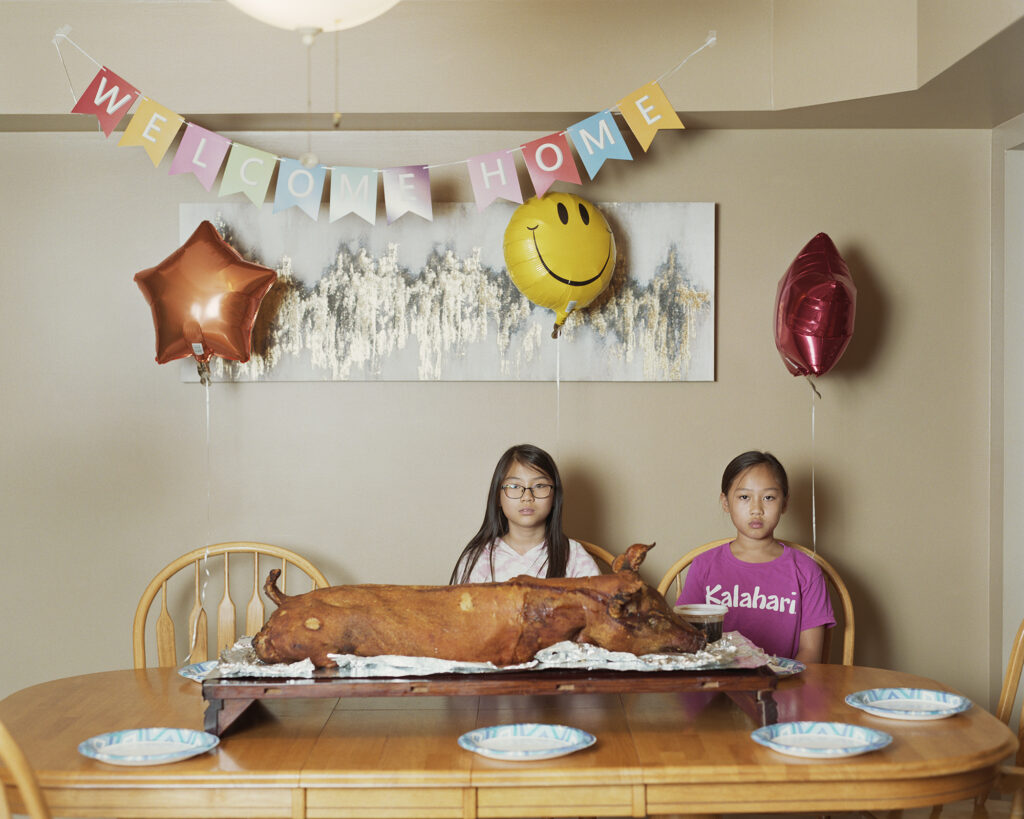
Jarod Lew, Welcome Home (Elina and Amelia), 2021; courtesy the artist; © Jarod Lew
RL: Something like 90% of how we understand each other is non-verbal. It’s not the words themselves, although it’s certainly part of it, but how we say it or the manner in which we say it.
JL: Or what we don’t say.
RL: Exactly. We learn our heritage through osmosis, and then we integrate it through fusion.
We’re Americans. Everybody could hyphenate — Italian American, German American. But nobody does that if they’re white. So why should we? The younger generation has begun this fusion. There’s a new hybrid citizen, and I really began to understand that from Chinese students coming over here to study art. They came here to understand and shape this new globalized world.
The extreme division in American culture and the exaggeration of individualism — this exceptionalism that Americans think they have — are leading us into disaster, period. We need more of the Asian model, the individual and the collective. You can’t separate the two.
What’s happening now regarding identity is different from what I experienced when I was younger. I remember this conversation with a curator at MoMA New York about my work in China. Nobody was talking about identity. Even though I had some degree of success and had a show at MoMA, I can’t say that I felt fully seen. This curator said, “I don’t care about what you’re feeling, I care about what I feel.” Okay, so we’re not going to be able to talk about work in another manner besides form.
JL: How do you look at the work that you made in China now that identity has become the main thing on the table and after living with it for years?
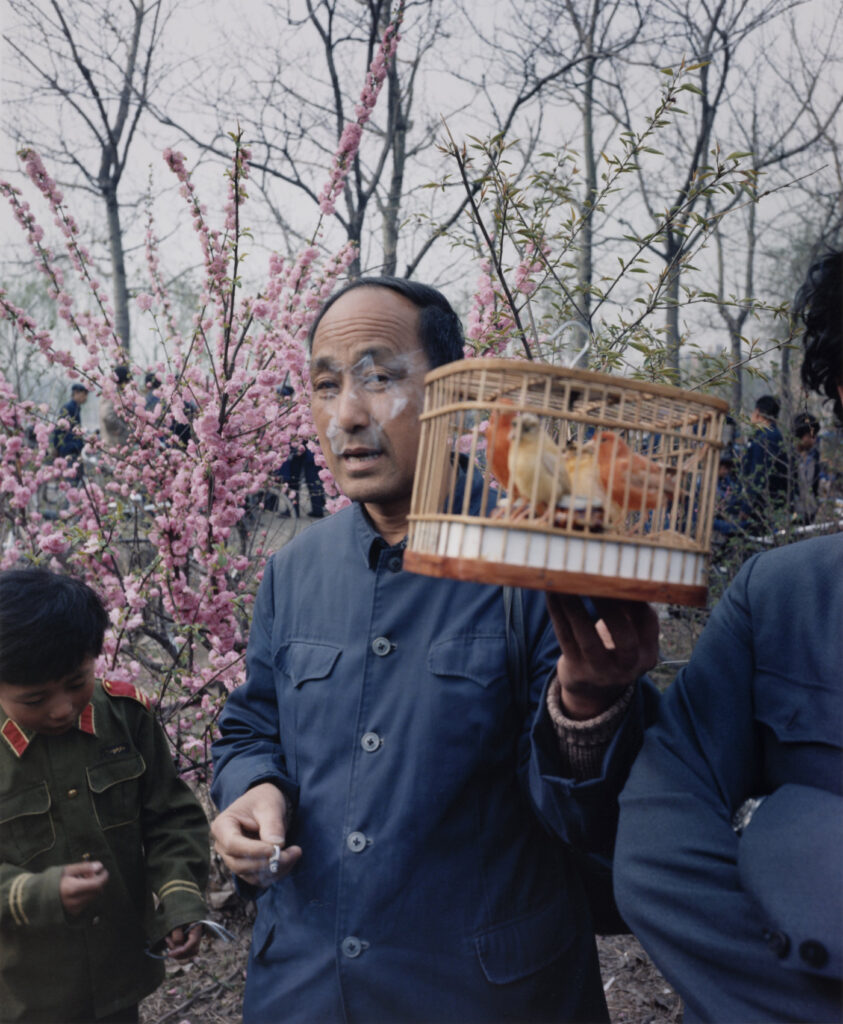
Reagan Louie, Beijing, 1987; collection SFMOMA, gift of Bill Press and Elana Auerbach; © Reagan Louie
RL: When I was at Yale, it was all about formalism. I was more a conceptual artist then, and only began to photograph after I left. Even the work I did in San Francisco Chinatown was measured in terms of how good the pictures were in terms of pictorial form.
I don’t know why I was photographing Chinatown, other than I lived there, it was convenient, kind of exotic, and I had some experiences there. I was making formal pictures, but I wasn’t thinking deeply about those memories or the past, although that began to leak in. I was having some degree of success, but I intuitively knew there was something missing in the work. I work intuitively. I’m not an intellectual.
JL: Yechen is always like, “Reagan is such an academic, he has such a rigorous way of thinking about work.” And I thought, “Absolutely.” But it’s funny to hear you say, “No, absolutely not.”
RL: Absolutely not. I just had this intuition to go to China. A new Chinese language program was being offered and I went. I wasn’t going to search for my roots. It was an opportunity, and China was a place not really seen yet. It was the next trip with my father that I began to think, “Oh, there’s something here.” That’s when I started thinking about what we’re talking about. I didn’t understand it well, in fact I was even fighting against it. When you’re raised in a white-dominant society, even though I succeeded in some ways, I still felt marginalized. I don’t know if the work has been fully discussed in the way that I understand it now. I’m hoping Yechen, other smart people, will do it for me. The work says what it says, right?
JL: That’s how I feel.
“I fell in love with how the world became quiet once my eye looked through the viewfinder. All the outside noise went away.”
RL: Why was photography the medium you chose to communicate these things?
JL: I was going in this weird path. I’d graduated with a graphic design degree. At that time graphic design was transitioning from print-based to web-based work, and my portfolio leaving undergrad was in print. So I left there with nothing, spent all this money and didn’t have a portfolio. That was in 2009, when the economy was going down the drain. It was hard to get a job, especially in Detroit. I’ve told this story before, but the grandmother of my partner at the time had a dream about me, that I worked for their photo studio, which was a mom-and-pop photography studio. It paid well and I was like, “Absolutely.”
I had only taken one college class in photography prior to working at this studio. Though it was a brief introduction, I fell in love with how the world became quiet once my eye looked through the viewfinder. All the outside noise went away. I loved that class. But I couldn’t explore photography further because of all the graduation requirements. In undergrad they said, “You are on a strict path to graduate so you only can take these classes.”
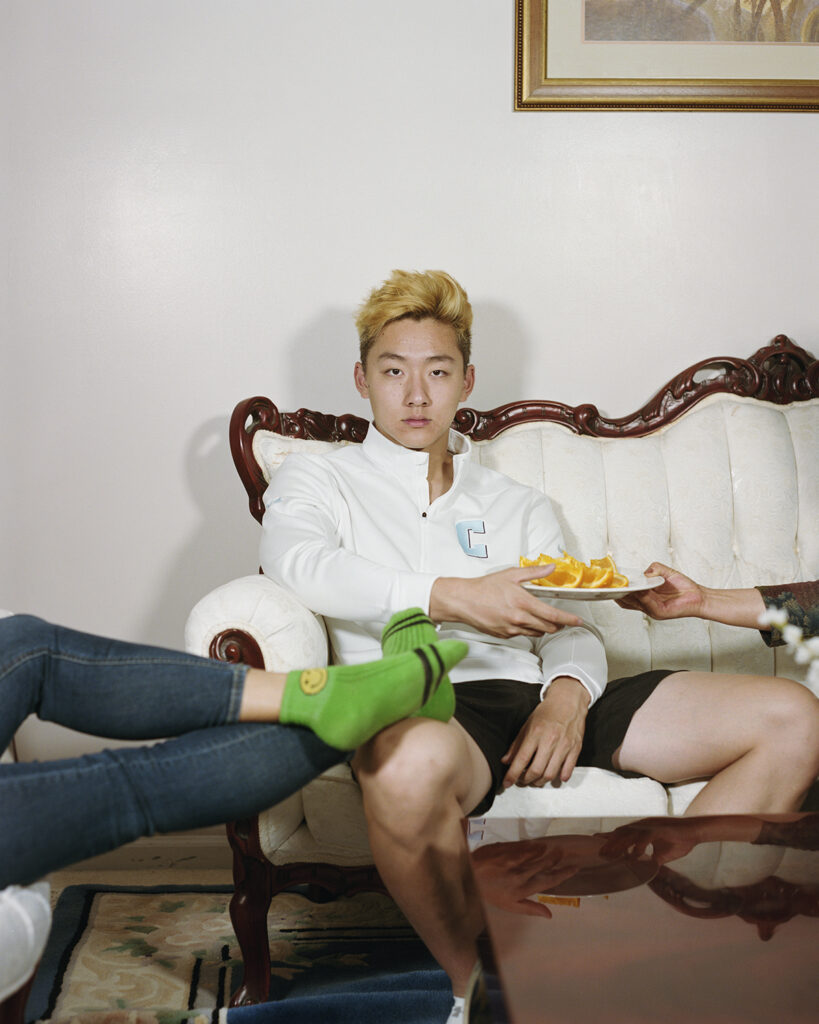
Jarod Lew, Consumption of Love (Eugene, Miyi, and Qun), 2020; courtesy the artist; © Jarod Lew
But I later became obsessed with the medium. And that’s when I found out about Vincent Chin. [Lew discovered his mother was the fiancée of Chin, a Chinese American man who was beaten to death by two autoworkers on the night of his bachelor party in 1982 Highland Park, MI. Chin’s murder and the accused killers’ probation led to protests by Asian Americans around the country.] Finding out that information was just so much . . . too much. I was learning how to take pictures, and then to find out that my family kept this huge secret in the shadows, I just had to repress it and concentrate on photography.
Photography for me is this way of being constantly hyperaware of the situation you’re in or the ideas that you want to express. The camera is the perfect way of translating those ideas and visual experiences. I was also good at painting but never had the patience to clean my brushes. The immediacy of making an image was something that I was and am still interested in, which is why I stuck with photography instead of painting. What about you?
RL: I went to UCLA to study with Richard Diebenkorn. I wanted to be a painter and was quickly disabused of it. I saw Diebenkorn twice. He came in the first day and said, “Here’s the TA.” And he left. He came back to us last class, said, “Good luck.”
The art world was undergoing a big shift. Modernism was evolving into different forms like conceptual art and I was swept up in that. In my last year there I covered all my paintings in gray and wrote at the bottom in stencils, “The End of Painting.” The painting faculty hated me. Then I found Robert Heinecken in the photography department and discovered this new tool, photography.
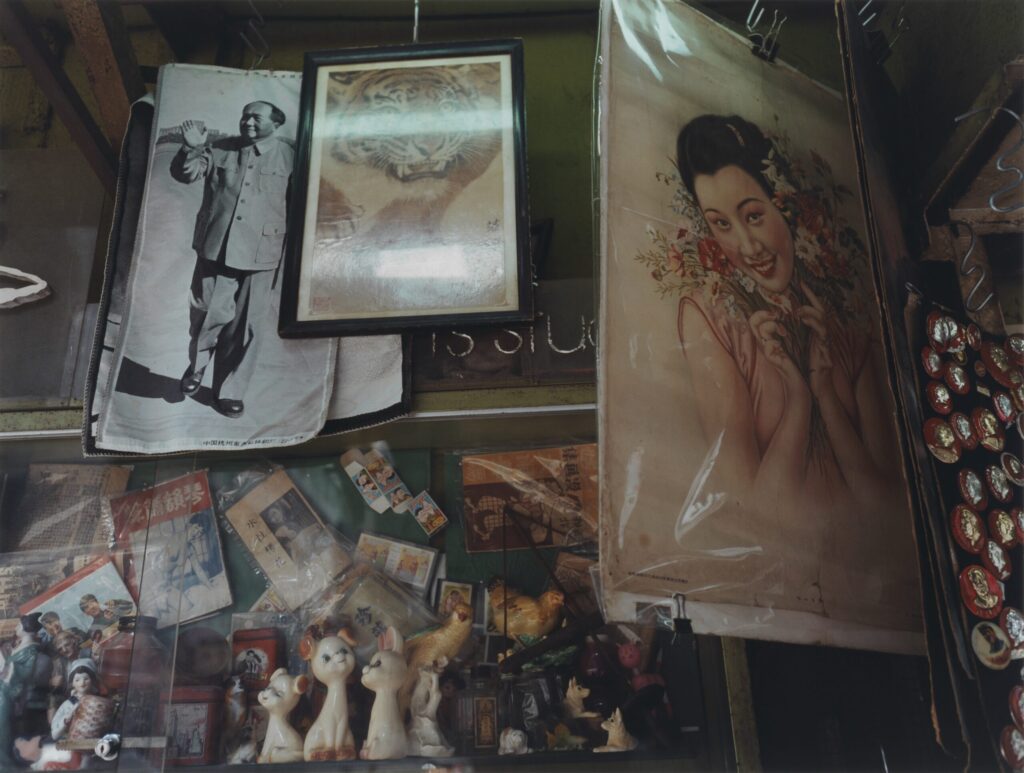
Reagan Louie, Hong Kong, 1995; collection SFMOMA, gift of Bill Press and Elana Auerbach; © Reagan Louie
I liked that photography was this new medium that wasn’t encumbered with all the art baggage and was still considered a commercial practice. I began to use it to document temporal sculptures I was doing. I also wanted to become a writer but wasn’t particularly good at it. I met Walker Evans who taught me that photography could be both a literate and a visual medium. It was important for me not to be a studio artist. I needed to be in the world, like what you were talking about. You must be engaged in the world to make the picture.
JL: There’s also this compulsion to get something more. Each picture I take is something that I could add to the archive that could narrate a narration. It’s a present. Each time you take a picture you gain something, and you get to see it and experience it over and over. That, I really love.
RL: Even the bad ones.
JL: Yeah, even the bad ones.
RL: The other thing that I like about photography is it’s about seeing in the deepest sense. Mostly people see through filters, right? As artists, our job is to interrogate those filters to see what’s really in front of us. If we do our work well, the viewer will have a different and deeper experience of the world.
The other thing I’m really focusing on these days is activating viewers to become participants in the world and not passive consumers. Younger artists are doing it. It’s not about exclusion, but inclusion.
JL: I love that you’re talking about activating the viewer into interacting with the image. It made me think about how I was photographing for the series Please Take Off Your Shoes. I was thinking about those folks who are considered gods of photography; how whenever someone sees a Stephen Shore or William Eggleston photo there’s this transportation of nostalgia because usually the person that’s looking at the image is white. So they look at this image made in the sixties by Eggleston and they’re like, “Oh my God, it’s so nostalgic. It’s the most amazing time for America,” blah, blah, blah. But for me as a Chinese American, I’m like, “Why can’t we have that same experience of nostalgia when we see a photograph that’s made of a Chinese American home or of China?”
At this point I know who my audience is, so I want them to be provoked into thinking about memories of their own experience, have the occasion to reflect while gazing at these homes I’ve photographed. I’ve been thinking a lot about this interaction between viewer and image and memory.
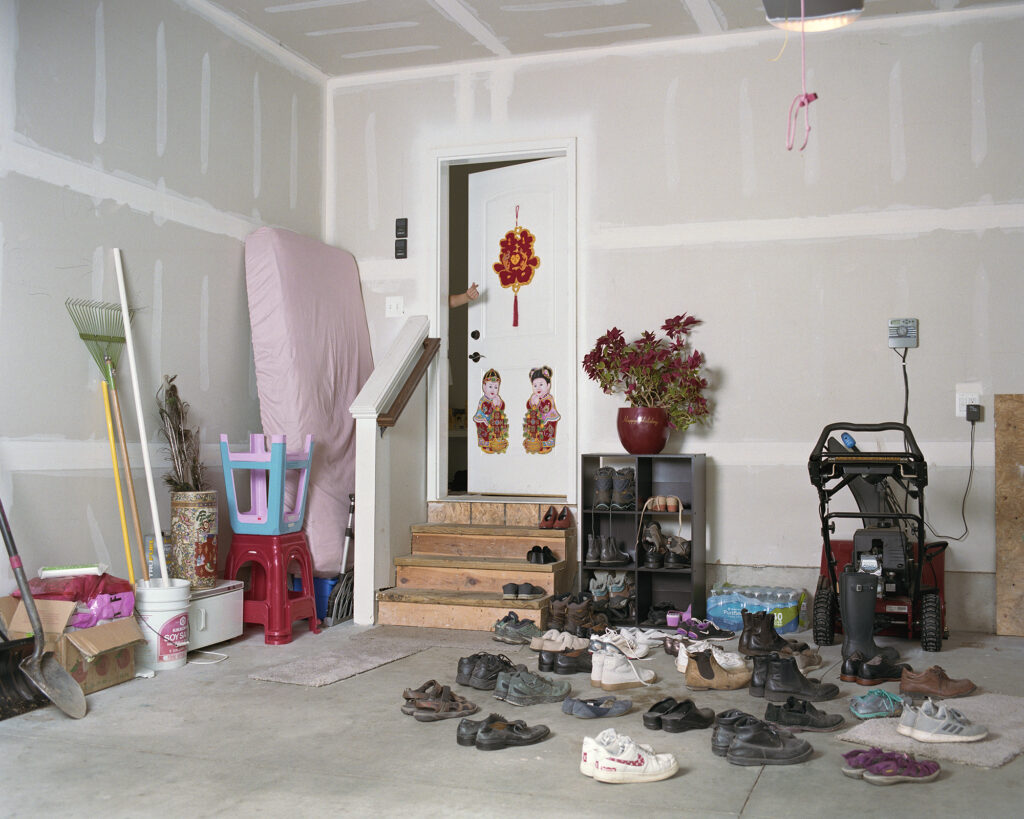
Jarod Lew, Please Take Off Your Shoes, 2021; courtesy the artist; © Jarod Lew
RL: And your work does that really well. I don’t want to be the cultural broker to explain Chinese history or Chinese Americans to non-Asians. I want to speak about my experiences as an American. These are American experiences. I don’t want to be pigeonholed; I don’t want anybody’s work to be pigeonholed. It’s not only about my struggle to understand that aspect of my heritage, but also about this global dynamic between China and America, China and the rest of the world. It’s complicated.
JL: And it’s archival material, documentation of this time of China as it’s transitioning. It’s very important to have that archive, right? Especially in America where it’s not happening unless you’re at Stanford.
RL: Stanford’s Asian American Art Initiative and Documenta were two important events for me last year. The monolith is starting to break up a bit, but we still have to be diligent and mindful of what we’re trying to do and say.
“Mostly people see through filters, right? As artists, our job is to interrogate those filters to see what’s really in front of us.”
JL: I’m excited that our exhibitions are overlapping because I think the dialogue between multigenerational artists within the community is going to be important for Asian Americans and everybody, just to see those aesthetics and different nuances in dialogue in the same space.
I remember you showing me a presentation when we had our first Zoom talk, and it was such a lovely surprise because it was totally unexpected. It was supposed to be a casual “Hi, how you doing?” But out of nowhere you said, “I have a slideshow, you want to see?” And I’m like, “Yeah, absolutely.”
Even though I was never really connected to China or Hong Kong there was this complicated emotion inside of me that felt connected to the work, even though I was not super connected to the place. I could see the intimacies and experiences you were having while photographing the community. That was moving for me as a younger generation Chinese American photographer. To see someone more experienced doing that work years ago was inspiring. It’s like, we exist, we just have to be put onto the platform to show the work. To see that platform pushed through, to be connected through Erin, was just like, “Oh yes, I found a good friend.” There was camaraderie when seeing your work for the first time.
RL: Erin and the younger generation of curators are another important reason why things are opening up. The work you did in other communities spoke to me in volumes. You had already established the importance of understanding and investigating your own heritage; it’s almost not important that the work was in China or that it was about Chinese America. It was about those connections you form with the people you’re photographing or the places you’re interacting in. You established that in that early work. So hang on, it’s going to be a real wild ride now.
JL: Yeah, yeah, yeah. I mean, we’re going to do it together, right?
RL: Absolutely. I feel bolstered in my practice by you and all the younger artists I’ve met recently. After a series of really tragic events, I was ready to just disappear. Stanford’s Asian American Arts Initiative pulled me back. The inspiration of Documenta pulled me back. After meeting you and other young artists, I feel like now I have a community. I have an audience or a group of people that I feel will understand.
JL: Whenever I have a conversation with you about life or work, it just feels like I’ve known you for a while as a friend, which is the best way to build a relationship with anybody.